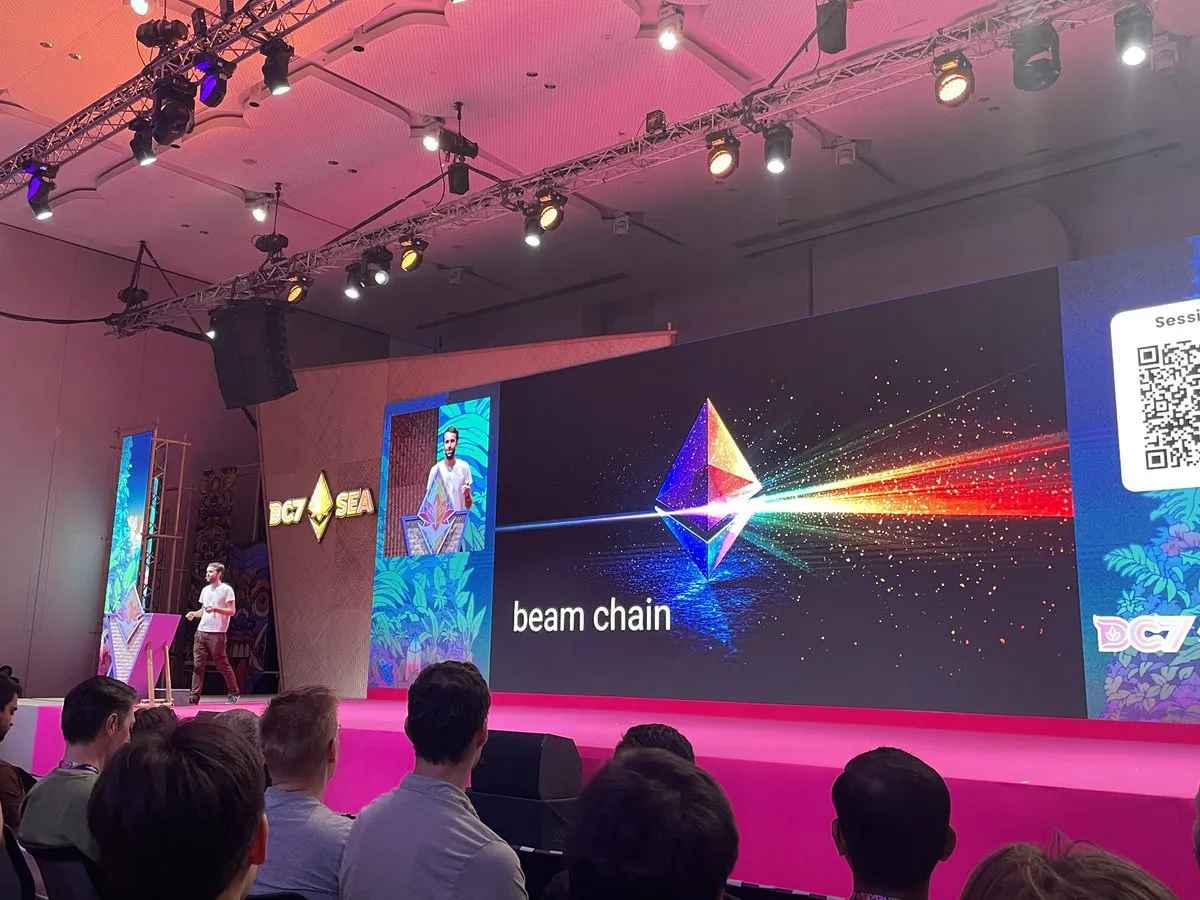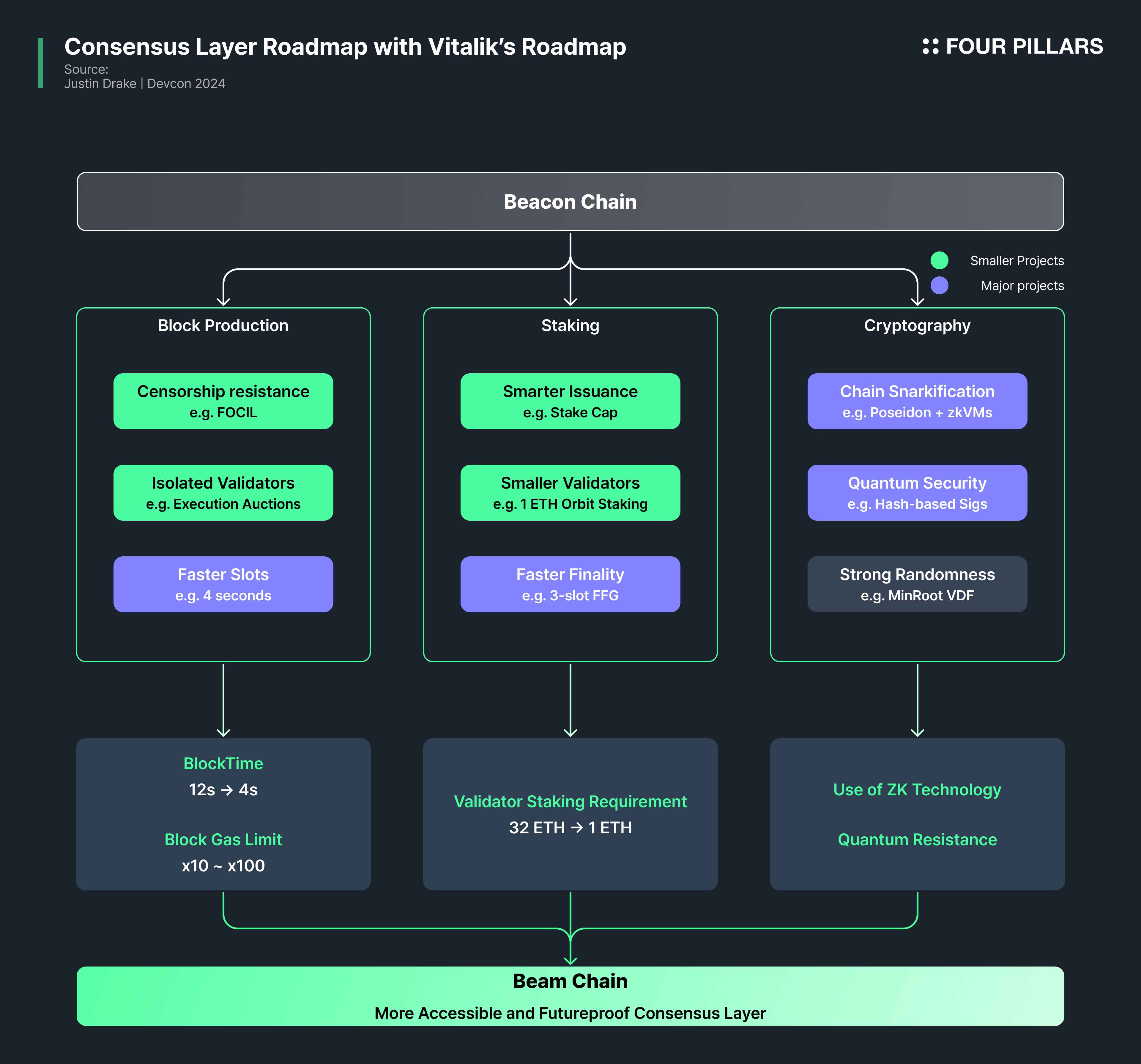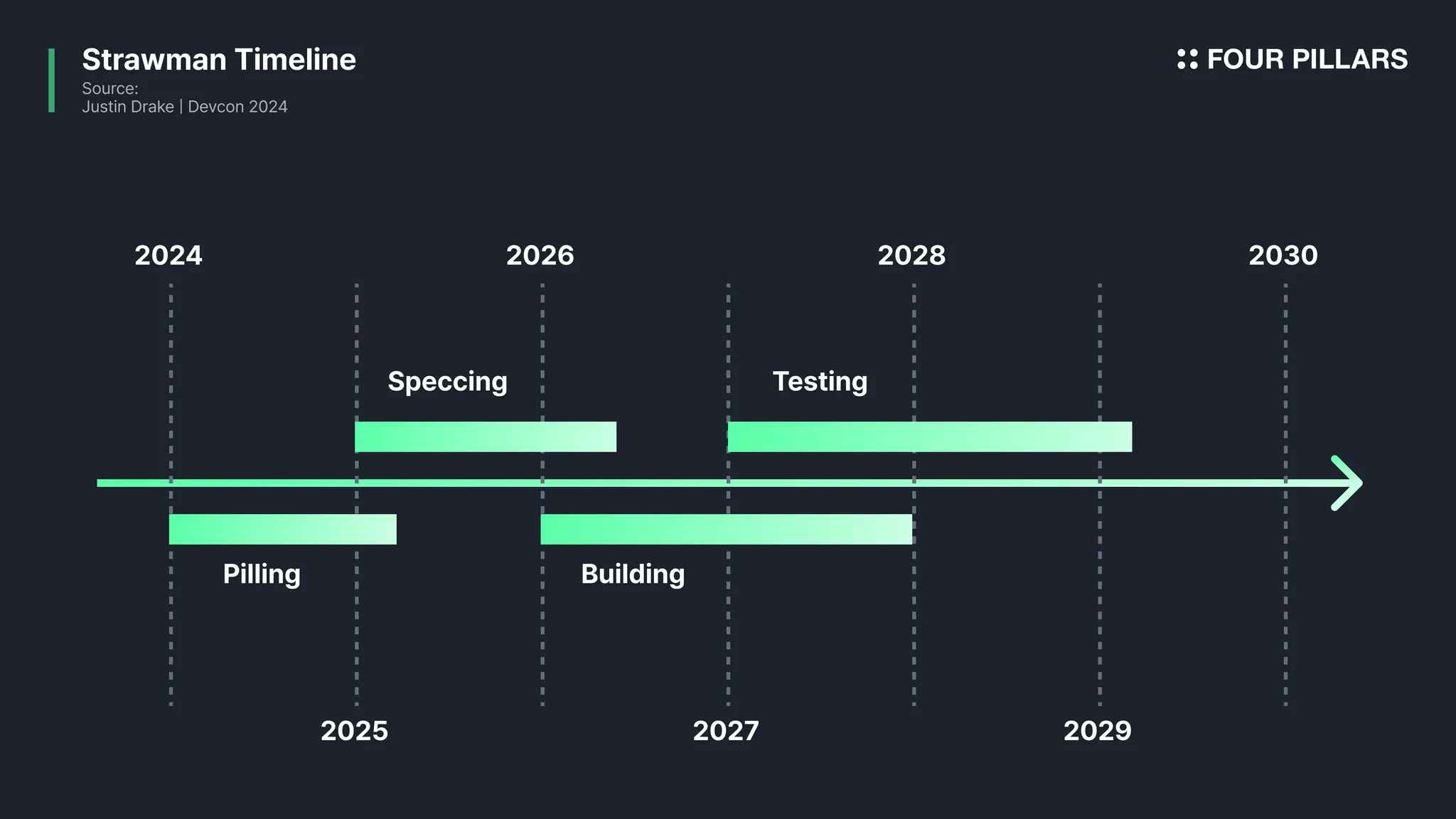At Devcon 2024, the Ethereum Beam Chain proposal was unveiled, targeting improvements in network performance and security. Key enhancements included reducing block creation time (from 12 seconds to 4 seconds), lowering the minimum validator staking requirement (from 32 ETH to 1 ETH), expanding the use of ZK technology, and increasing the gas limit (by 10 to 100 times). While this was seen as a positive effort to strengthen Ethereum's scalability and decentralization, the announcement was criticized for insufficient engagement with the Ethereum community and a slow roadmap (targeted for 2029).
Although Beam Chain proposed significant improvements in efficiency and decentralization, its announcement sparked disappointment among Ethereum community members and experts. Concerns were raised about the mismatch between its long-term roadmap and the rapid pace of change in the blockchain industry. Critics highlighted the need for Ethereum to adopt a more agile and innovative approach to maintain its competitiveness.
José Maria Macedo of Delphi Ventures and Mert from Solana's development platform Helius expressed concerns over the Beam Chain's lack of competitiveness and slow development timeline. On the other hand, Péter from the Ethereum Foundation and Cygaar from Abstract emphasized the need for sufficient preparation and a phased approach to safely implement such a large-scale transformation. They suggested that technical stability and governance risks must be carefully considered.
As a leader in the blockchain ecosystem, many argue that Ethereum must maintain community trust and strengthen its competitive edge. The Beam Chain proposal showcases Ethereum’s potential while presenting a new challenge of balancing swift innovation with careful execution.

Source: porter X
From November 12 to 15, 2024, Devcon 2024 in Bangkok, Thailand, hosted a highly anticipated event featuring Justin Drake, a researcher from the Ethereum Foundation, who introduced the Ethereum Beam Chain proposal.
In this presentation, Drake outlined Ethereum's roadmap, proposing Beam Chain as a replacement or enhancement to the existing Beacon Chain. The goal: improve network performance and security by expanding the use of Zero-Knowledge Virtual Machines (ZK-VMs), shortening slot times, and increasing gas limits, among other upgrades.

Details of the Beam Chain’s features, as presented during the event and The Rollup YouTube channel, include:
Faster Block Generation Time: Reducing Ethereum’s block generation time from approximately 12 seconds to 4 seconds, enhancing transaction throughput and network efficiency.
Lower Validator Staking Requirement: Decreasing the minimum staking threshold from 32 ETH to 1 ETH to encourage broader participation in network validation.
Proactive Use of ZK Technology: Building on Ethereum’s transition from PoW to PoS, Beam Chain integrates ZK technology, enhancing security and scalability. ZK proofs for each block ensure a trustworthy environment for users and developers.
Higher Gas Limits to Address Bottlenecks: Beam Chain proposes increasing Ethereum’s current gas limit (30 million gas per block) by 10 to 100 times. This aims to accommodate more transactions and dramatically boost network scalability. Drake emphasized this improvement as a crucial step for Ethereum to compete with other Layer 1 blockchains.
Enhanced Interoperability with L2: Beam Chain seeks to improve interoperability between Layer 1 and Layer 2. By introducing single-slot finality, it addresses slow transaction processing caused by L2’s reliance on L1 block finality, fostering faster and more secure L2 operations.
Quantum Resistance: The proposal includes measures to fortify network security against future quantum computing threats.
Valuation Model for $ETH: Drake discussed Ethereum’s long-term valuation framework based on two elements: ETH’s fee cycle (derived from network fee revenue) and monetary premium (its role as a reliable store of value). He argued that these components are foundational to Ethereum’s sustained value.

Additionally, Justin Drake explained that the Beam Chain aims to address issues identified in Ethereum's current Beacon Chain design. He emphasized that community consensus would be essential for implementing the proposal.
According to the roadmap schedule, initial specification work could begin as early as next year. The timeline includes development in 2026, a comprehensive testing phase in 2027, and at least two years of stability validation. Based on this plan, the official launch of the Beam Chain is projected for 2029.
Since its initial launch in 2015, Ethereum has consistently upgraded its system through hard forks. Notably, "The Merge" upgrade, often referred to as Ethereum 2.0, marked a major shift by changing Ethereum’s consensus mechanism from Proof of Work (PoW) to Proof of Stake (PoS). Following this, upgrades like Shapella and Dencun have enhanced Ethereum's efficiency and user convenience, but there hasn’t been a clear indication of preparing for a radical transformation within Ethereum itself.
Amid this lingering sense of anticipation within the Ethereum community, the announcement of Ethereum's next goals at Devcon 2024 addresses this thirst for progress.
The timing of this announcement seems particularly appropriate because it shifted the focus back to Ethereum itself, creating a new buzz, just as many were growing fatigued by the trend of concentrating solely on external ecosystems centered around L2. Additionally, as previously mentioned, the presentation of a roadmap for Ethereum’s focus and future direction adds considerable significance to this development.
The Beam Chain proposal includes several commendable aspects, particularly its focus on improving and strengthening the consensus layer with an emphasis on network efficiency and decentralization. Key elements include reducing block generation time, increasing block gas limits, and lowering the minimum staking requirement for validators.
Faster block generation time is a characteristic of many competing Layer 1 chains, and Ethereum’s adoption of this trend—reducing block generation time from 12 seconds to 4 seconds—is a noteworthy development. While it remains slower compared to Solana, it signifies a departure from Ethereum’s previous reluctance to compromise stability for speed, marking a meaningful shift.
The proposal to increase the block gas limit by 10 to 100 times could be particularly appealing to users, developers, and Layer 2 projects. A higher gas limit would allow more data to be included in each block, significantly enhancing Ethereum’s usability and versatility.
Finally, lowering the minimum staking requirement for validators is a major step toward increasing decentralization, one of Ethereum’s core values. Currently, becoming a validator requires staking at least 32 ETH, which, as of November 19, 2024, equates to approximately $100,000—a prohibitively high barrier for many individual participants. This has led to the rise of liquid staking platforms like Lido and Rocket Pool, which ironically centralize staking within their ecosystems. By reducing the minimum staking requirement to 1 ETH, the Beam Chain could enable more individuals to participate directly as validators, further decentralizing the Ethereum network.
However, the reception to the proposal has not been entirely positive. While Ethereum’s stagnant price may be a contributing factor, the community’s lukewarm response suggests deeper concerns.
The proposed changes address pressing issues that Ethereum needs to resolve, so the individual suggestions themselves are not flawed. The problem lies in the lack of a cohesive narrative about Ethereum’s direction—a strength that has previously guided its development. This absence has left many disappointed.
Moreover, the roadmap’s slow timeline, aiming for a 2029 launch, feels misaligned with the blockchain industry’s rapidly evolving pace. This raises questions about whether the Ethereum Foundation fully grasps the urgency of maintaining relevance in such a dynamic environment. While the Beam Chain proposal contains elements of innovation, its protracted schedule has led some to doubt Ethereum’s ability to adapt swiftly enough to stay competitive.
Another perspective that resonates with me comes from a post in a Telegram channel I frequently follow:
"If Ethereum aims to champion decentralization, shouldn't it have demonstrated this clearly and transparently from the outset? The Ethereum community and EIP framework were already well-established, so why was there a need for such secrecy in preparing and announcing this proposal?"
It was impossible not to agree upon encountering this opinion. Since its inception, Ethereum has steadfastly upheld decentralization, even at the cost of network scalability. However, the process of gathering feedback and announcing the Beam Chain proposal feels significantly detached from this principle.
Ethereum's strength lies in its robust and active community—the largest in the blockchain industry—and the EIP ecosystem that aggregates various ideas. Yet, this announcement was made abruptly, without prior notice or hints within this ecosystem. Although the announcement included a disclaimer stating that it was a proposal from a researcher and not the Ethereum Foundation's official stance, and that it was intended to spark community discussion, the lack of a cautious and well-prepared build-up to the proposal made the impact less significant, leaving much to be desired.
This approach risks exacerbating the already fragile sentiment surrounding Ethereum, potentially fostering a negative perception and stifling its growth engine. Furthermore, even though it is a rough proposal, the lack of broader exposure to EIPs or community discussions means that the opinions of actual Ethereum network users and builders may not be adequately reflected.
The Beam Chain announcement has drawn sharp criticism from many prominent figures and community members in the blockchain space. However, such heated critiques reveal the high expectations people still have for Ethereum. After all, criticism is a form of engagement—those who don’t care wouldn’t bother voicing their concerns.

Source: LoL Esports YouTube
Of course, Heavy is the Crown. As the reigning leader of smart contract platforms and a pioneer of the Web3 ecosystem, Ethereum must face every obstacle head-on and continually prove itself. It must listen closely to even its harshest critics and ensure that no idea within the EIP framework, no matter how small, is wasted.
Ethereum is a blockchain network that I personally support, and it remains one of the largest projects with an incredibly strong narrative. However, even a project of this magnitude is not immune to falling into complacency or losing its edge in the face of competition. In this fast-paced industry, the slightest lapse in vigilance can lead to being left behind.
Crises are inevitable, and everyone faces them at some point. The way Ethereum chooses to navigate this current challenge will mark a crucial turning point, determining whether it experiences a REVIVAL or FADES into obscurity.
José Maria Macedo, founding partner of Delphi Ventures, expressed his disappointment with the Beam Chain proposal. He criticized the proposal for its limited core improvements, which he described as mere codebase restructuring, a 4-second block time, and "quantum attack resistance." Moreover, he pointed out that these improvements are only expected to materialize by 2029–2030. Macedo argued that such incremental changes are insufficient for Ethereum L1 to maintain its edge in the blockchain competition or achieve long-term competitiveness.
Mert, CEO of Solana’s development platform Helius, also voiced concerns about the Beam Chain’s development timeline. He projected that if Beam Chain is not released until 2029, Ethereum will struggle to retain its competitiveness in the rapidly evolving blockchain space.
Péter, a key member of the Ethereum Foundation, raised concerns about the Beam Chain proposal attempting to bundle too many changes together. From a technical perspective, he warned that combining numerous changes increases the likelihood of errors. From a governance standpoint, he cautioned against the risk of overlooking details and sparking controversy. Péter suggested tackling simpler improvements in the Beacon Chain first and implementing more complex changes gradually over time.
Cygaar, a developer at Abstract, explained the necessity of the five-year timeline for Beam Chain. He highlighted Ethereum’s status as the world’s second-largest blockchain, with $60 billion in TVL, $400 billion in asset value, and thousands of applications relying on its network. Implementing large-scale changes in such a decentralized and real-time ecosystem carries immense risks, making thorough preparation and testing essential. He emphasized that investing sufficient time is the only way to introduce changes safely and responsibly.
Related Articles, News, Tweets etc. :
Dive into 'Narratives' that will be important in the next year